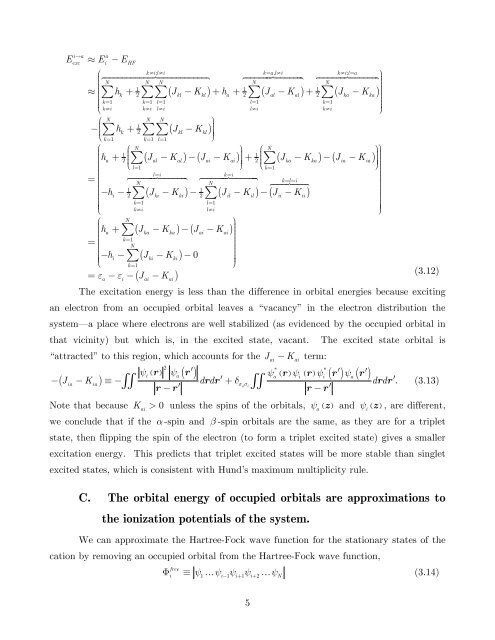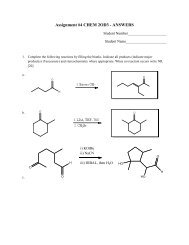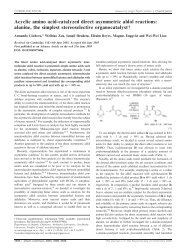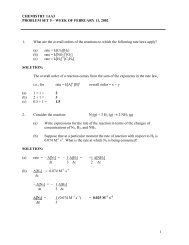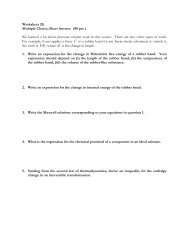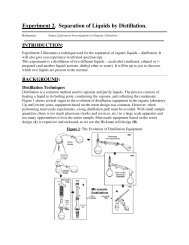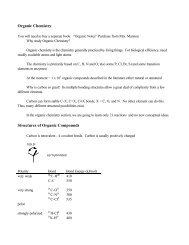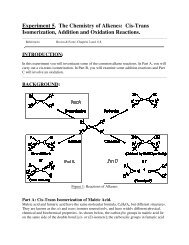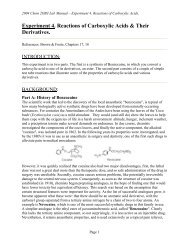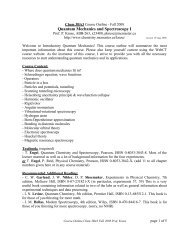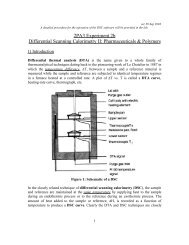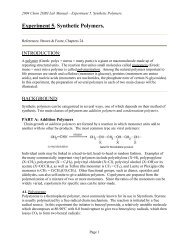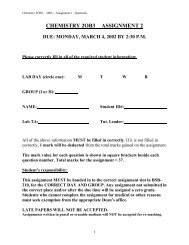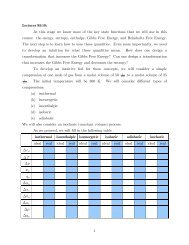N N N1∑ε2 ∑∑ ( ). (<strong>3.</strong>9)E = − J −KHF i ij iji= 1 i= 1 j=1The reason is because <strong>the</strong>re is a “double counting” <strong>of</strong> electron-electron repulsions in Eq.(<strong>3.</strong>8): <strong>the</strong> energy <strong>of</strong> an orbital is <strong>the</strong> kinetic energy plus electron-nuclear attraction energyplus <strong>the</strong> electron-electron repulsion (with exchange corrections) to all <strong>the</strong> o<strong>the</strong>r orbitals in<strong>the</strong> system. However, in <strong>the</strong> total energy formula, we count <strong>the</strong> electron repulsion betweenorbitals i and j only once—not once for ψ ( )ir interacting with ψ ( )jr and a second time forψ r interacting with ψ ( r ), as in Eq. (<strong>3.</strong>8).( )jiBased on <strong>the</strong> preceding argument, and using <strong>the</strong> fact J ij> K ij, we see that if youassume <strong>the</strong> total energy is <strong>the</strong> sum <strong>of</strong> <strong>the</strong> orbital energies, you obtain an energy that is toobig. Indeed, <strong>the</strong> energy so computed is usually extremely poor.At first, <strong>the</strong> result in Eq. (<strong>3.</strong>9) may be counterintuitive: shouldn’t <strong>the</strong> electronicenergy <strong>of</strong> a molecule be <strong>the</strong> sum <strong>of</strong> <strong>the</strong> energies <strong>of</strong> <strong>the</strong> composing electrons? Equation (<strong>3.</strong>9)says this is not <strong>the</strong> case, but gives us little insight into why it is not <strong>the</strong> case. To make thisa bit more clear, suppose his kind students enroll your pr<strong>of</strong>essor in <strong>the</strong> local chapter <strong>of</strong>Misanthropes Anonymous.B. The energy it takes to excite an electron from an occupiedorbital, ψ ( )iz , to a unoccupied orbital, ψ ( )az , is not equal to <strong>the</strong>difference in <strong>the</strong> orbital energies, ε a− ε i.We can approximate <strong>the</strong> <strong>Hartree</strong>-<strong>Fock</strong> wave function for an excited state <strong>of</strong> <strong>the</strong>system by replacing an occupied orbital with an unoccupied orbital in <strong>the</strong> <strong>Hartree</strong>-<strong>Fock</strong>wave function, obtaining <strong>the</strong> Slater determinantΦ ≡ ψ … ψ ψ ψ ψ … ψ . (<strong>3.</strong>10)ai 1 i− 1 a i+ 1 i+2 NNote that this Slater determinant is not stationary with respect to <strong>the</strong> energy: because <strong>of</strong><strong>the</strong> self-consistency requirement, exciting an electron changes and <strong>Fock</strong> operator, whichcauses <strong>the</strong> orbitals to change. When we skip <strong>the</strong> self-consistent procedure that produces this“revision” in <strong>the</strong> orbitals due to <strong>the</strong> excitation, we say that have neglected orbitalrelaxation. Neglecting orbital relaxation, <strong>the</strong> excitation energy can be approximated withi a a ˆ aE → ≈ Φ H Φ − Φ HˆΦ (<strong>3.</strong>11)exc.i i HF HFand, using <strong>the</strong> formula for <strong>the</strong> energy <strong>of</strong> a Slater determinant, Eq. (<strong>3.</strong>7), we obtain4
E ≈ E −Ei→a aexc i HF⎛k≠i; l≠ i k= a, l≠i k≠ i;l=a⎞ N N N N N1 1 1≈ hk 2 ( Jkl Kkl ) ha 2 ( Jal Kal ) 2 ( Jka Kka)∑ + ∑∑ − + + ∑ − + ∑ − ⎜k= 1 k= 1 l= 1 l= 1 k=1⎜⎝k≠i k≠i l≠i l≠i k≠i⎠⎟⎛N N N⎞1− ⎜∑hk +2 ∑∑( Jkl −Kk)l⎜⎝k= 1 k= 1 l=1 ⎠⎟⎛ ⎛N⎞ ⎛N⎞⎞1 1h a 2 ( Jal Kal) ( Jai Kai) 2 ( Jka Kka) ( Jia Kia)+ − − − + − − −⎜∑⎟ ⎜∑⎝ l= 1 ⎠ ⎝k=1⎠⎟l= i k=i= NNk==l i1 1−hi −2∑( Jki −Kki) −2∑( Jil −Kil) −( Jii −Kii)k= 1 l=1⎝⎜k≠i l≠i⎟⎠⎛N⎞ ha + ( Jka −Kka) −( Jai −Kai)∑k=1= N⎜−hi −∑( Jki −Kki)−0⎜⎝ k=1⎠⎟= εa −εi −( Jai −K(<strong>3.</strong>12)ai)The excitation energy is less than <strong>the</strong> difference in orbital energies because excitingan electron from an occupied orbital leaves a “vacancy” in <strong>the</strong> electron distribution <strong>the</strong>system—a place where electrons are well stabilized (as evidenced by <strong>the</strong> occupied orbital inthat vicinity) but which is, in <strong>the</strong> excited state, vacant. The excited state orbital is“attracted” to this region, which accounts for <strong>the</strong> J ai− K aiterm:2( )* *ψi r ψa( r′ ) ψ ( ) ( )ar ψi r ψi ( r′ ) ψa( r′)−( Jia−Kia) ≡− ∫∫drdr′ + δσσd d ′.a i− ′ ∫∫r r (<strong>3.</strong>13)r r r −r′Note that because Kai> 0 unless <strong>the</strong> spins <strong>of</strong> <strong>the</strong> orbitals, ψ ( )az and ψ ( )iz , are different,we conclude that if <strong>the</strong> α -spin and β -spin orbitals are <strong>the</strong> same, as <strong>the</strong>y are for a tripletstate, <strong>the</strong>n flipping <strong>the</strong> spin <strong>of</strong> <strong>the</strong> electron (to form a triplet excited state) gives a smallerexcitation energy. This predicts that triplet excited states will be more stable than singletexcited states, which is consistent with Hund’s maximum multiplicity rule.C. The orbital energy <strong>of</strong> occupied orbitals are approximations to<strong>the</strong> ionization potentials <strong>of</strong> <strong>the</strong> system.We can approximate <strong>the</strong> <strong>Hartree</strong>-<strong>Fock</strong> wave function for <strong>the</strong> stationary states <strong>of</strong> <strong>the</strong>cation by removing an occupied orbital from <strong>the</strong> <strong>Hartree</strong>-<strong>Fock</strong> wave function,Φ ≡ ψ … ψ ψ ψ … ψ(<strong>3.</strong>14)freei 1 i− 1 i+ 1 i+2 N5


